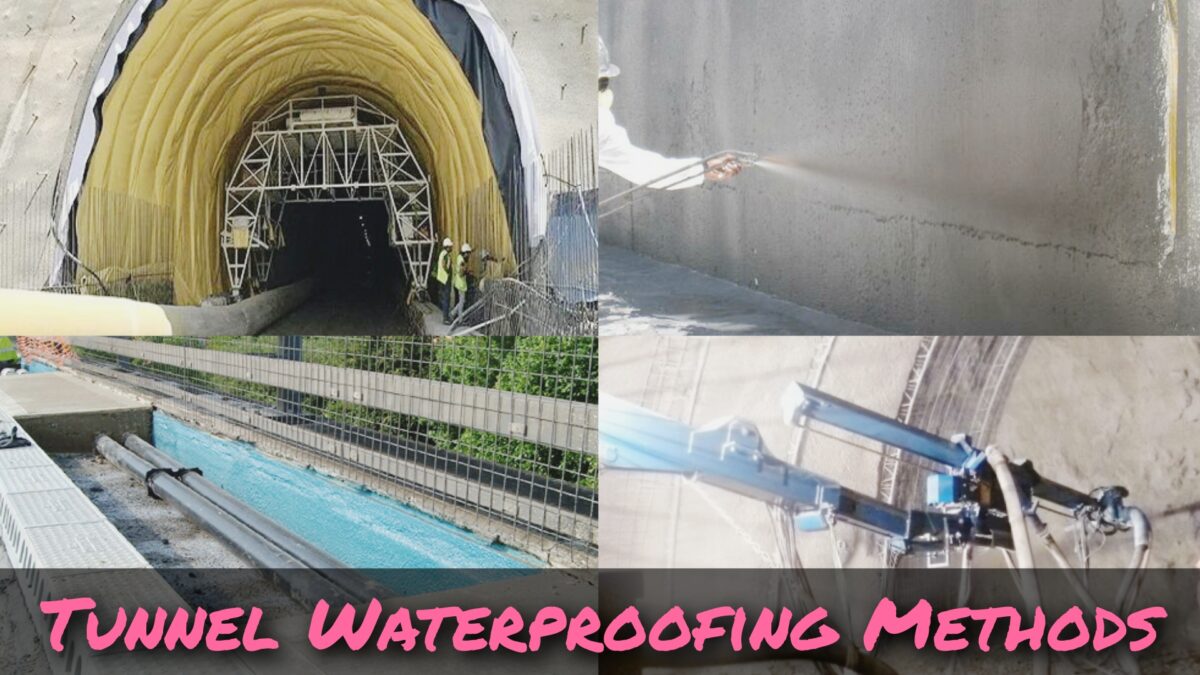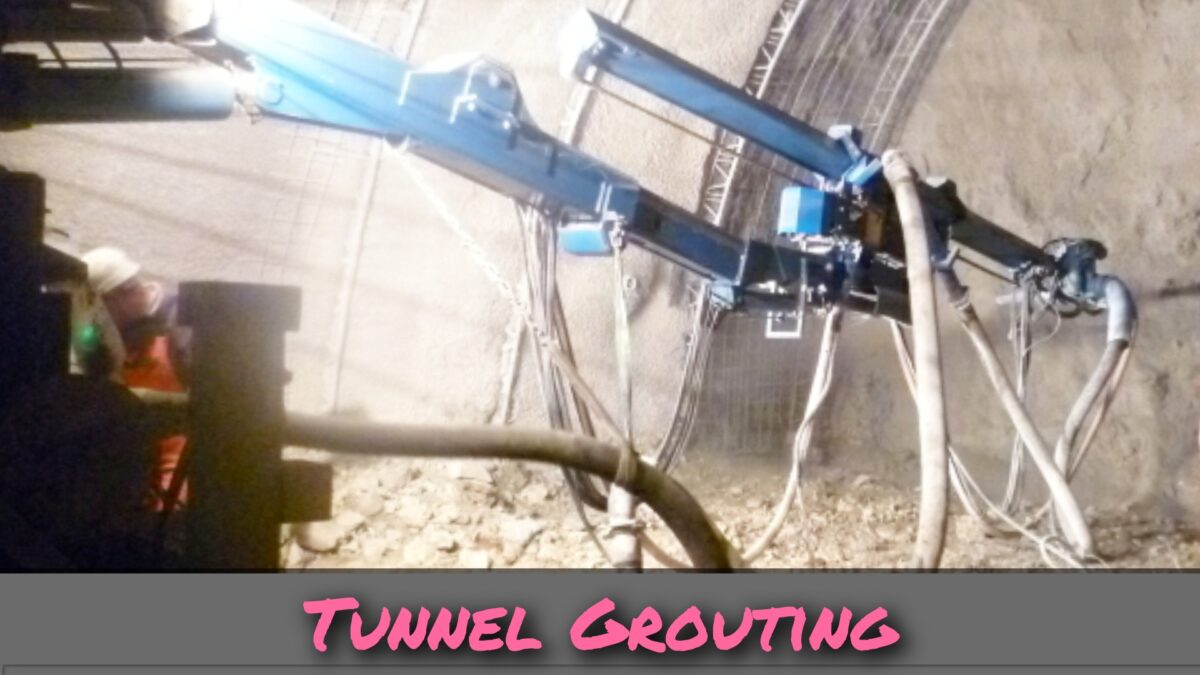Table of Contents
What Is Tunnel Waterproofing?
Tunnel waterproofing system is used to make tunnels resistant to water penetration and ensuring their structural integrity.
Tunnels are normally built in environments where they encounter groundwater, high water tables, or potential water seepage from surrounding soil or bodies of water.

Waterproofing measures are implemented to prevent water ingress and protect the tunnel’s infrastructure from damage.
Methods Of Tunnel Waterproofing
1. Sheet Membrane Waterproofing:
We use a special layer called a membrane that stops water from going into the tunnel.

This layer can be made of materials like a sticky substance called bitumen, a strong plastic called PVC, or a type of rubber called EPDM.
The membrane acts like a shield to keep water away.
2. Cementitious Waterproofing:
We put a coating or a slurry made of cement on the tunnel surfaces.

This cement layer creates a strong barrier that water cannot go through.
Sometimes, we use this method along with other ways to make it even better at keeping water out.
3. Injection Waterproofing:
When there are cracks or spaces in the tunnel, we inject a special liquid material into them.

This liquid then becomes a seal that stops water from getting through. It’s like filling the holes with a special material to block the water.
4. Grouting:
Grouting means putting a cement-like material into the ground around the tunnel.

This helps make the ground stable and reduces the amount of water that can flow into the tunnel.
It fills empty spaces and makes the ground stronger.
5. Drainage Systems:
Sometimes, we install systems to collect water and move it away from the tunnel.

These systems can have channels, pumps, and pipes to take the water out quickly.
This way, the water doesn’t stay near the tunnel and cause any problems.
Benefits Of Tunnel Waterproofing System
1. Protection against water damage:
Tunnel waterproofing prevents water intrusion into the tunnel structure, thereby protecting it from potential damage caused by moisture, such as deterioration, corrosion, and weakening of the materials.
2. Increased structural durability:
Waterproofing enhances the overall durability of the tunnel by minimizing the adverse effects of water exposure.
It helps to maintain the structural integrity and strength, prolonging the lifespan of the tunnel.
3. Prevention of leaks:
Waterproofing systems effectively seal any existing or potential leaks in the tunnel, ensuring that water cannot seep through cracks, joints, or other vulnerable areas. This prevents water from entering and causing problems within the tunnel.
4. Enhanced safety:
Water infiltration can create hazardous conditions within the tunnel, including slippery surfaces and weakened structures.
Waterproofing reduces these risks and improves safety for both users and maintenance personnel.
5. Preservation of tunnel aesthetics:
Moisture and water ingress can lead to unsightly stains, discoloration, and efflorescence on the tunnel surfaces.
Waterproofing protects the appearance of the tunnel, helping to maintain its visual appeal.
6. Reduction of maintenance costs:
By implementing tunnel waterproofing, the frequency and extent of maintenance required to address water-related issues are significantly reduced. This leads to cost savings over the lifespan of the tunnel.
7. Prevention of mold and mildew growth:
Moisture and high humidity levels in tunnels can create an ideal environment for mold and mildew to thrive.
Waterproofing measures inhibit the growth of these harmful organisms, contributing to a healthier and safer environment.
8. Improved air quality:
Waterproofing helps to maintain good indoor air quality within the tunnel by preventing the infiltration of moisture, which can lead to the accumulation of pollutants and the development of unpleasant odors.
9. Resistance to chemical damage:
Some tunnels may be exposed to chemicals, such as those found in wastewater or industrial effluents.
Waterproofing systems can provide resistance against chemical corrosion, protecting the tunnel structure from degradation.
10. Enhanced insulation properties:
Certain waterproofing techniques, such as spray-applied membranes or insulation panels, can also contribute to improved thermal and acoustic insulation in tunnels.
This helps to regulate temperature and reduce noise levels, enhancing the comfort and usability of the tunnel.
Sum Up
We need to remember that how we make a tunnel waterproof depends on different things, like the kind of ground, how high the water is, how much pressure the water has, and how the tunnel is designed.
Making a tunnel waterproof is very important for the tunnel’s durability and safety.
Faqs
A tunnel waterproofing system helps stop water from going inside tunnels. It’s important because without it, water can cause damage and make tunnels unsafe.
A tunnel waterproofing system works by putting a special layer on the walls and floor of the tunnel. This layer stops water from coming in. It’s like a big umbrella for the tunnel, keeping it dry and safe.
A tunnel waterproofing system is good because it protects tunnels from water damage. It keeps them strong and safe for people to use. It also makes sure there’s no water inside the tunnel, so it’s not wet or moldy.
A tunnel waterproofing system can last for a very long time, like many, many years. But it needs to be checked sometimes to make sure it’s still working well. If there’s any damage, it might need to be fixed or redone.
Yes, tunnels that are already built can be made waterproof. It might be a bit harder, but there are ways to do it. They check the tunnel first and then put on the special layer to stop the water. This makes the tunnel safe and dry.
